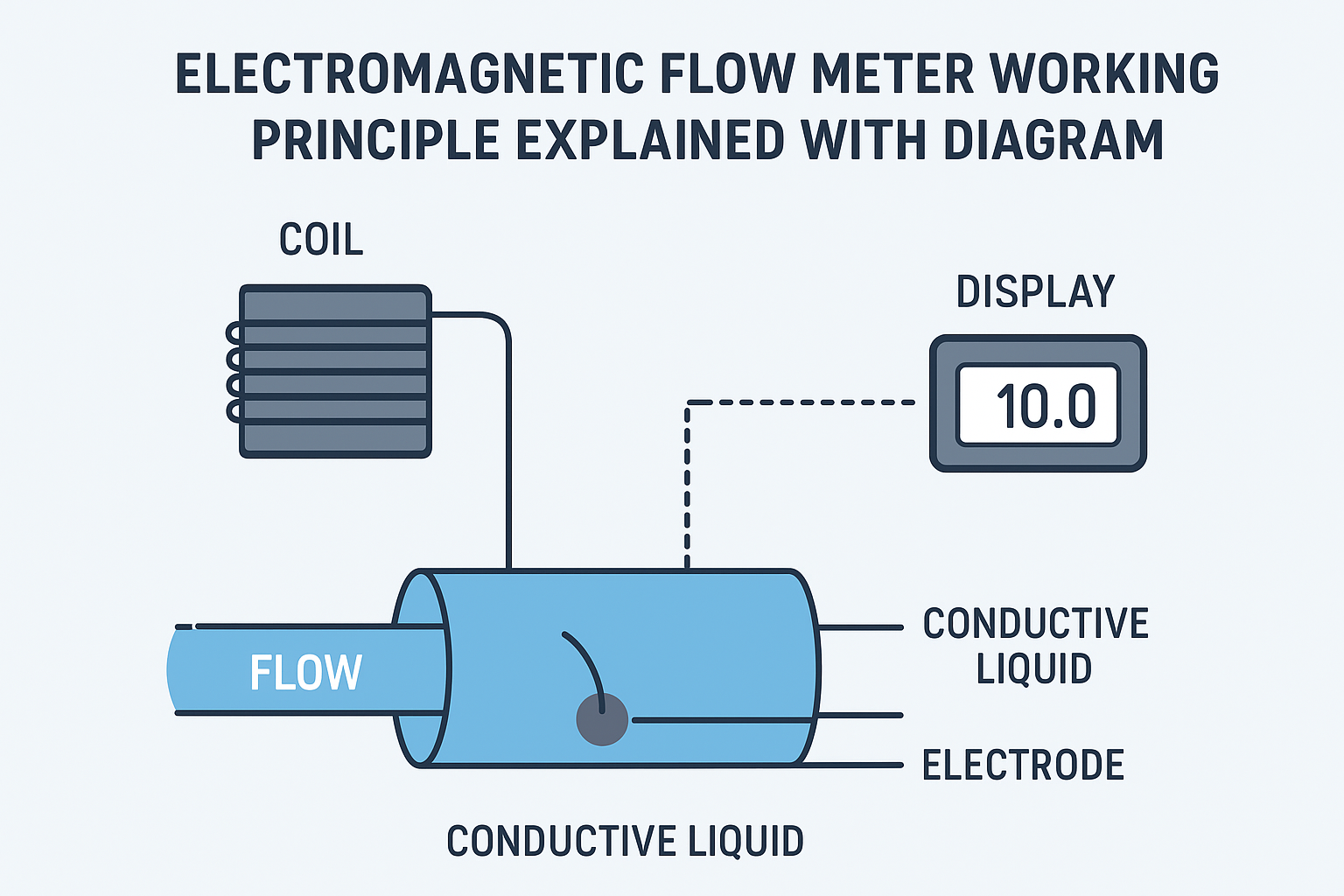The Electromagnetic Flow Meter Working Principle is based on Faraday’s Law of Electromagnetic Induction, where a voltage is induced when a conductive fluid flows through a magnetic field. This induced voltage is proportional to the fluid’s velocity, and when multiplied by the pipe’s cross-sectional area, it gives the flow rate. Widely used in industries such as water supply, wastewater treatment, food & beverage, pharmaceuticals, and chemical processing, electromagnetic flow meters deliver ±0.5% accuracy with no moving parts, making them maintenance-free and ideal for long-term use. In this blog, we explain the Electromagnetic Flow Meter Working Principle with diagram, discuss its applications, advantages, and why industries trust experts like us for flow measurement solutions.
What is an Electromagnetic Flow Meter?
An electromagnetic flow meter (or magmeter) is a device used to measure the flow rate of conductive liquids like water, slurry, acids, and chemicals.
- It works without any moving parts.
- Provides accurate results even with dirty or corrosive fluids.
- Common in industries where precision and durability are critical.
Electromagnetic Flow Meter Working Principle
The Electromagnetic Flow Meter Working Principle can be broken down into 4 steps:
- Magnetic Field Creation – A pair of coils generates a magnetic field inside the pipe.
- Conductive Fluid Flow – As fluid passes through this magnetic field, it induces a voltage.
- Electrode Detection – Electrodes placed inside the pipe detect this induced voltage.
- Flow Rate Calculation – The meter’s electronics convert the voltage into flow rate using the formula:
Q=k×V×D2Q = k \times V \times D^2Q=k×V×D2
Where:
- Q = Flow Rate
- k = Constant
- V = Velocity of fluid
- D = Diameter of pipe
This simple yet powerful principle ensures precise flow measurement.
Electromagnetic Flow Meter Working Principle Explained with Diagram
Below is a simple diagram representation:

Coil (Magnetic Field)
↓
[ Pipe with flowing liquid ] → Electrodes detect voltage → Flow rate displayed
This shows how electromagnetic flow meters operate without obstruction, making them suitable for fluids with suspended solids.
Applications of Electromagnetic Flow Meter
The Electromagnetic Flow Meter Working Principle is used across industries:
- Water Supply & Wastewater Treatment – Leak detection, distribution monitoring
- Chemical Industry – Corrosive liquid measurement
- Food & Beverage – Dairy, juice, beer, and sugar solutions
- Pharmaceuticals – High-purity liquids
- Mining & Pulp & Paper – Slurries and viscous materials
Advantages of Electromagnetic Flow Meters
- High Accuracy: ±0.2–0.5%
- No Pressure Loss: Since there are no obstructions
- Durable & Reliable: Withstands harsh fluids
- Wide Range: Works for small pipes to large industrial pipelines
- Low Maintenance: No moving parts → long lifespan
Why Electromagnetic Flow Meter Working Principle is Important
The Electromagnetic Flow Meter Working Principle is critical because it ensures:
- Accurate billing in water distribution
- Regulatory compliance in wastewater discharge
- Reduced losses in chemical and food industries
- Optimized production efficiency
Without accurate flow measurement, industries risk waste, penalties, and inefficiency.
Why Choose Us for Flow Measurement Solutions?
We are industry leaders in electromagnetic flow meters, with years of expertise in designing, implementing, and maintaining accurate flow measurement systems. Whether you need solutions for municipal water supply, industrial pipelines, or specialized chemical processes, our experts ensure maximum precision and reliability.
👉 Partner with us for trusted electromagnetic flow meter solutions that keep your operations running smoothly.

